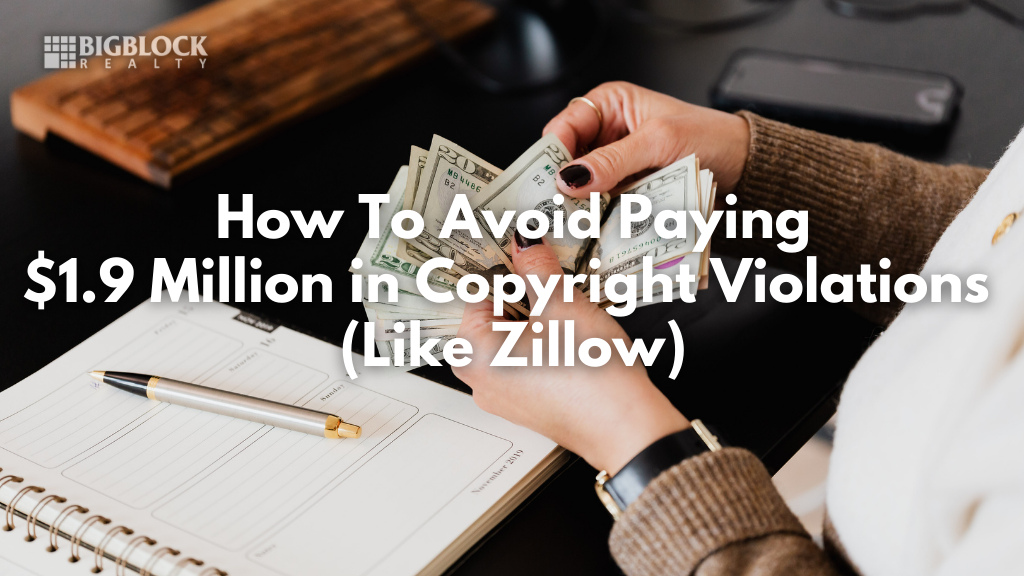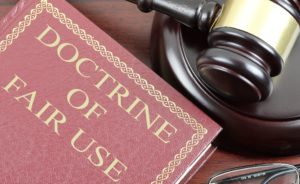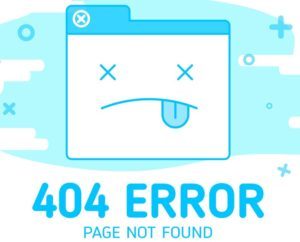 Learn how to avoid paying $1.9 Million for copyright violations like Zillow.
Learn how to avoid paying $1.9 Million for copyright violations like Zillow.
Last January 27, a federal court ordered Zillow to pay $1.9 million to the copyright owner of images used on its website without permission. This is known as “Copyright Infringement”.
Zillow was ordered to pay $1.9 million in copyright case
KEY TAKEAWAYS
- On January 27, 2022, a federal court ordered Zillow to pay $1.9 million in a copyright violation case.
- The original court judgment was for $9 million later reduced by the Ninth Circuit Court of Appeals.
- Zillow did what millions of real estate agents do every day.
- Copying and pasting Copyrighted images (or content) onto a blog or website without the copyright owner’s permission is Copyright Infringement.
- Copyright violators are subject to federal lawsuits and Google Takedown of the blog post and web page leaving a 404 Error that the offending URL no longer exists.
- Exceptions to U.S. Copyright laws exist.
- Learn how to copy and paste copyrighted images and content the right way to avoid lawsuits for Copyright Infringement and Google Takedowns.
- Learn how to find non-copyrighted and licensed for free use images.
- Protect your original content and images by posting this simple notice.
How Zillow Violated Federal Copyright Laws
Zillow did what millions of Realtors and real estate agents do every day. However, they copy and pasted copyrighted images onto their website the wrong way.
In Zillow’s case, they used to own a website called “Zillow Digs” which used copyrighted images of interior homes as examples of how homeowners can price home renovations.
Google shut down that website for copyright violations. Also, the producer of the original images sued Zillow for copyright infringement and won a $9 million judgment. On appeal, the Ninth Circuit Court of Appeals (which California is in) reduced it to $1.9 million.
Know The U.S. Copyright Laws
Before explaining the U.S. Copyright laws, it’s best to explain what types of content and images come under the law.
What Is Copyright?
Here’s a good definition of copyright.
Every author, artist, photographer, and image-maker has the exclusive right to own his or her original work.
Note: Notice how I include the “ “ symbols before and after the quoted words above? Also, how I hyperlink the entire quoted words to their original internet source? Keep reading to learn why.
Understand the U.S. Copyright Law
The Copyright Act of 1976 regulates copyrights in the U.S. This law protects authorship of original works published in a “tangible medium of expression”.
A “tangible medium of expression” includes blog posts, online articles, web pages, and other media. The author receives automatic copyright protection under federal law for “original work”.
The best way to establish content as “original work” on the internet is to copy and paste the content on an internet scanning site like Copyscape which verifies if the content is 100% original.
Images are also considered original works by the photographer, artist, or anyone creating unique images using software like Canva.
This article explains the federal copyright laws in greater detail: How to Avoid Copyright and Plagiarism.
How to Legally Copy and Paste Copyrighted Images and Content

Image Source – Licensed for Use by the Fair Use Doctrine.
The Fair Use Doctrine
An exception to U.S. Copyright laws allows free use of copyrighted content and images on blogs and web pages. It’s called the “Fair Use Doctrine”.
The Copyright Alliance Organization explains the Fair Use Doctrine as:
The Massachusetts Institute of Technology (MIT) explains a four-factor test used by U.S. courts to determine if it’s Fair Use:
- The Purpose of Use: Is it “educational” or “commercial”?;
- The Type of Work: Is it “fact-based content” or “commercialization”?;
- The Amount of Copyright Work Used: Was it “only a small amount used for a specific purpose?”; and
- Market Effect: “Did it affect the copyright owner’s ability to earn income?”.
Explanation – A copyrighted work used by a real estate agent solely to “criticize, comment, report news, or teach viewers” is legal. Also, using “fact-based content” is needed for its purpose. And, not depriving the copyright owner of any income from its usage.
In other words: Establish Fair Use when your blog or web page uses copyrighted content and images to educate viewers. Also, its usage doesn’t prevent the copyright owner from gaining income.
The Purpose of the Fair Use Doctrine

Image Source: Licensed for Free Use by Creative Commons licenses.
Note: A Creative Commons license allows others to use original images and content as long as “attribution” is given to its original source.
The U.S. Copyright laws recognize the public’s right to legally use parts of copyrighted content and images to criticize or comment about them. Also, the right for the news media to report, scholarly research, and people using them to teach without requiring copyright owners’ permission.
For example, blogs and forums can comment, review, and criticize copyrighted works.
The U.S. Copyright Office explains “fair use” on its website. “Courts look at how the party claiming fair use is using the copyrighted work, and are more likely to find that nonprofit educational and noncommercial uses are fair.”
The U.S. Copyright Office also points out that, “Courts review whether, and to what extent, the unlicensed use harms the existing or future market for the copyright owner’s original work”.
Informational Purpose versus Commercial Use
Informational Purpose: Stanford University asserts permission is not required when others use copyrighted works for “informational purposes”.
Informational Blogs and Web Pages: While blogs and websites promote products and services, they can “educate viewers”. U.S. courts look at blogs and web pages to see if they are selling or giving information. “The more website space devoted to selling, the less likely the use is informational.”
How To Use The Fair Use Doctrine For Images
Here are the three factors for using the Fair Use Doctrine for images you use in your blog and web pages:
- The image is not used for direct commercial gain (like an advertisement to promote sales);
- The image must contain an original “Source” URL underneath it; and
- Next to the “Source” is an explanation of the Licensing or Right of Usage.
Note: You may have noticed how underneath each image I add an “Image Source” URL link and the words “Licensed under the Fair Use Doctrine” with a URL link to the U.S. Copyright Office explaining allowable fair usage.
This protects you from a Google Take Down for copyright violations and from a lawsuit from the copyright owner.
Google Take Down Order

Image Source: Licensed for Free Use by Creative Commons licenses.
Besides avoiding a copyright infringement lawsuit, beware of Google taking down your blog post or web page.
Google penalizes copyright violations by using a U.S. federal copyright law called the Digital Millennium Copyright Act (DMCA) that protects content and images on the internet.
Any copyright owner can file a request with Google (and all the other search engines) to remove the offending blog post or web page from the internet. It’s called a DMCA Takedown request. In addition to search engines, the copyright owner can file this request with the violator’s U.S. internet service provider (ISP).
Because Google is headquartered in the U.S., it allows copyright holders to make a “Legal Removal Request” under the DMCA. Google explains this process and how to file the removal request. Google acts fast when receiving these take-down requests.
How To Find Non-Copyrighted and Licensed for Free Use Images
Surprisingly, there are thousands of online images available to copy and paste for free usage. You just need to know where to find them.
Here is a hyperlink to an article listing 15 sites allowing free use of high-quality images and several sites with free image editing tools: How to Find Images for Free Use.
How To Protect Your Original Online Content and Images

Image Source: Licensed for Free Use by Creative Commons licenses.
A specific Copyright Notice protects your rights. Place a notice of the originality of your blog posts and web pages for all to see, like this:
Copyright © 2022 (Your or Company Name) at the bottom of each blog post and web page gives you greater rights.
How To Avoid Paying $1.9 Million Copyright Violation Like Zillow – Conclusion
Now that you learned how to avoid paying $1.9 Million for copyright violations like Zillow, put it to use.
If you copy copyrighted content and images for your blog or website, do it the right way.
Follow these steps to protect yourself, your company, and broker from copyright violation lawsuits and Google Take Downs for Images:
- The image is not used for direct commercial gain (like an advertisement to promote sales);
- The image must contain an original “Source” URL underneath it; and
- Next to “Source” explain the Licensing or Right of Usage.
Copyrighted content requires:
- Copying the content and using quote symbols ( “ and “) before and after;
- Include the Source URL either within the quoted content or afterward; and
- Make sure the content is not used to directly sell your products or services.
We Got Your Back!
Big Block Realty helps our Realtors to stay out of trouble by providing informational blog posts and courses explaining laws and ethics. This post is just one example of the many resources we provide our Realtors. Also, our broker is a licensed California attorney available to assist.
Join Us in San Diego County along with over 985 other Realtors making us one of the nation’s largest non-franchised brokerages. So many Realtors join us because we offer these benefits:
- Complete transparent 100% Commission Plans with no hidden fees;
- Free Training Courses;
- Broker/Attorney Support; and
- Agent Concierge Services.
Steven Rich, MBA – Guest Blogger
HAVE ANY QUESTIONS?
Let us know, we love to help:
Call: (800) 550 – 3209
or Click: https://100commissionrealestate.com/contact
—
Connect with Big Block…
SUBSCRIBE TO OUR CHANNEL: https://www.youtube.com/@bigblockrealty?sub_confirmation=1
CONNECT WITH US ON SOCIAL HERE: https://bigblockrealty.com/social/
Find us on Instagram: https://www.instagram.com/BigBlockRealty_
–
ARE YOU AN AGENT LOOKING TO EARN 100% COMMISSION?
JOIN BIG BLOCK REALTY: https://www.100commissionrealestate.com







0 Comments